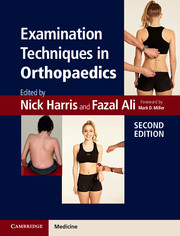Book contents
- Frontmatter
- Dedication
- Contents
- List of contributors
- Foreword
- Preface
- Acknowledgements
- 1 General principles of orthopaedic clinical examination
- 2 Examination of the shoulder
- 3 Examination of the elbow
- 4 Examination of the wrist
- 5 Examination of the hand
- 6 Examination of the peripheral nerves in the hand and upper limb
- 7 Examination of the adult spine
- 8 Examination of the hip
- 9 Examination of the knee
- 10 Examination of the foot and ankle
- 11 Examination of the brachial plexus
- 12 Orthopaedic examination techniques in children
- 13 Examination of the spine in childhood
- Index
- References
13 - Examination of the spine in childhood
- Frontmatter
- Dedication
- Contents
- List of contributors
- Foreword
- Preface
- Acknowledgements
- 1 General principles of orthopaedic clinical examination
- 2 Examination of the shoulder
- 3 Examination of the elbow
- 4 Examination of the wrist
- 5 Examination of the hand
- 6 Examination of the peripheral nerves in the hand and upper limb
- 7 Examination of the adult spine
- 8 Examination of the hip
- 9 Examination of the knee
- 10 Examination of the foot and ankle
- 11 Examination of the brachial plexus
- 12 Orthopaedic examination techniques in children
- 13 Examination of the spine in childhood
- Index
- References
Summary
Introduction
The spectrum of conditions of the spine in children includes spinal infection, trauma, tumours, spondylolysis and spondylolisthesis, the adolescent disc syndrome, as well as spinal deformities such as scoliosis.
The clinician should be alerted to the quality and site of any painful spinal symptoms, in terms of whether or not it is activity-related and if there is any neuropathic pain. Worrying symptoms include night pain causing disturbed sleep, unremitting pain requiring regular analgesia and pain interfering with enjoyable activities. The younger the patient, the more likely it is that any spinal tumour is neoplastic, with 75% of spinal tumours in the under-6s being malignant, contrasting with less than 33% in over-6s who have spinal tumours. The benign but painful osteoblastoma and osteoid osteoma occur principally around the thoracolumbar junction and the pain is typically relieved by non-steroidal anti-inflammatory drugs. Although pain is a cardinal feature of spinal malignancy, present in 46–83% of cases, only about one in three cases will present purely with pain and two-thirds will present with neurological problems, such as radicular pain, muscle wasting and weakness and/or a limp. Most children with an underlying neurological or neuromuscular condition will already have a diagnosis, and a previously fit and healthy child who develops new weakness and/or a limp should be suspected of having a spinal tumour until proven otherwise.
- Type
- Chapter
- Information
- Examination Techniques in Orthopaedics , pp. 190 - 197Publisher: Cambridge University PressPrint publication year: 2014



